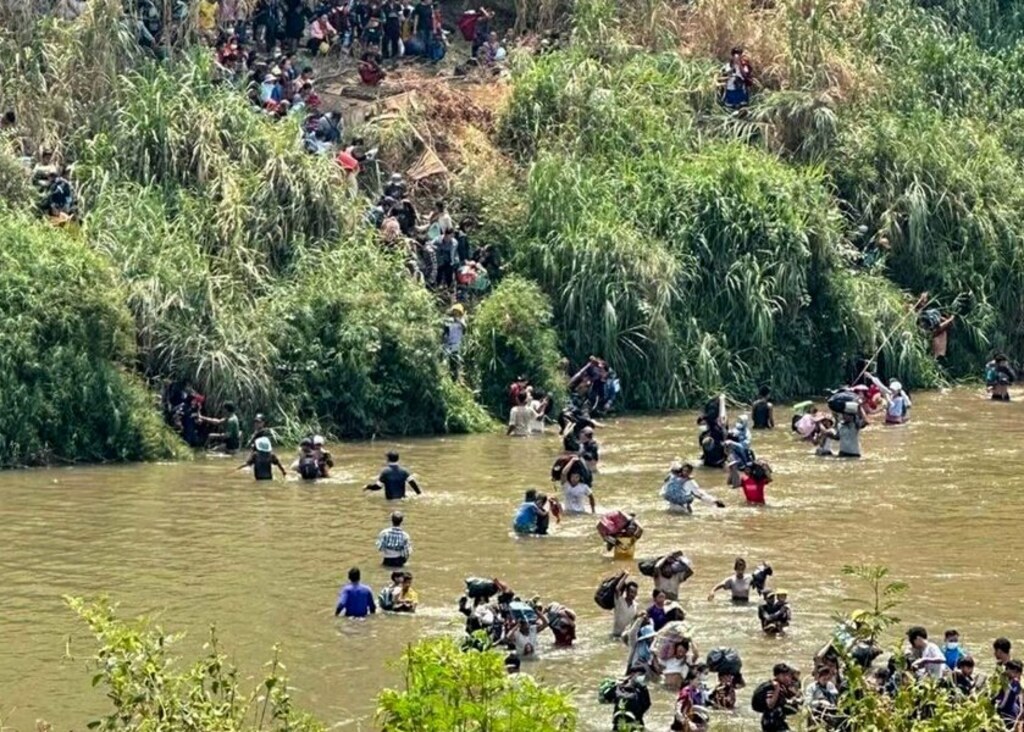News
Thousands, Including More than 800 Children Flee Fighting Myanmar

Thai officials and aid workers have reported that more than 5,000 people have fled from eastern Myanmar into Thailand in recent days as combat between Myanmar’s army and armed resistance groups has risen along the border.
According to Thai PBS, at least 5,428 civilians, including more than 800 children, crossed the border from Myanmar’s Myawaddy district to seek sanctuary in Thailand’s Tak province on Wednesday night, citing an unidentified security officer.
It said they fled as ethnic Karen insurgents linked with pro-democracy People’s Defense Force guerrillas attacked two Myanmar government outposts near the border. Regular army forces are aided by members of the Border Guard Force, which is made up of ethnic minority militias affiliated with the military administration.
Myanmar’s ethnic minorities have been striving for more autonomy for decades, but the country’s armed conflict erupted dramatically when Myanmar’s army deposed Aung San Suu Kyi’s democratic government in February 2021. In several parts of the country, widespread opposition to the coup shifted to violent resistance as pro-democracy forces joined forces with various armed ethnic minority organizations.
Clashes and air attacks along the border have resulted in a sporadic outflow of Myanmar peasants into Thailand’s border regions, where they are frequently provided temporary refuge before being sent home. Streams of refugees from western Myanmar have also arrived in India.
Villagers Flee Myanmar
According to an officer from Thailand’s border district of Mae Sot, fighting on Myanmar’s side of the border continued Thursday, and shooting could be heard from the Thai side. The official, who not to be identified because he was not allowed to divulge information, estimated that at least 5,000 migrants are currently in Thai authorities’ care.
“We are providing them with shelter, food, and water on humanitarian grounds,” he explained. “We’ll wait until things settle down.” We’ll send them back when the fighting stops.”
According to the Bangkok Post, around 1,000 individuals escaped across the border into Thailand on Thursday at two different locations.
Thailand’s Thai-Myanmar Border Command Center stated in a statement a day earlier that officials in Tak province had given 10 temporary shelters to house refugees in two border districts, including Mae Sot, a significant crossing site.
According to Tak province’s Public Relations Department, the battles happened at two locations within Myawaddy province around 6 kilometers (4 miles) from the border, resulting in “several injuries and deaths for soldiers on both sides.”
Civilians dying at an alarming rate in Myanmar
According to sources on the Thai side, thousands of people escaped across the Moei River, which marks the border, to escape fighting on Thursday, according to the website of Myanmar’s Eleven Media Group.
It claimed they were attempting to flee violence in Myanmar’s Shwe Kokko region, which has a semi-autonomous economic zone with a casino and alleged criminal operations in which people duped into working are employed in large-scale computer scams.
According to its assessment, the current wave of violence in the area began on March 25.
Civilians are dying at an alarming pace in Myanmar’s civil conflict, dying in airstrikes, artillery shelling, and incarceration, according to data supplied by an armed ethnic group opposing the regime.
According to the Progressive Karenni People’s Force, 447 civilians have been slain in the eastern state of Kayah, which borders northern Thailand, since the military took control of the country in a coup two years ago.
According to an official with the group who talked to Radio Free Asia on the condition of anonymity due to security concerns, almost two-thirds of them were killed after being kidnapped by military, while the others perished while feeling conflict.
“Civilians were killed because they were hit by the junta’s… artillery fire,” he explained. “Another reason is the junta’s airstrikes against civilians.”
“Some were killed by military forces after they were arrested, and others died due to a lack of medicine to cure them,” he explained.
According to Thailand’s Assistance Association for Political Prisoners, the junta killed 3,206 individuals across the country during the same time period. (Burma).
Since the February 2021 coup, the region has been at war. According to him, the Burmese army has clashed with the ethnic Karenni Army and the Karenni Nationalities Defense Force up to 650 times.
Myanmar Military War Crimes
According to Banyar, director of the Karenni Human Rights Organization, Junta soldiers have progressively broken the rules of war and perpetrated atrocities that amount to war crimes.
“We are witnessing open war crimes and crimes against humanity committed by the military council,” he stated. “Civilian deaths have risen because the junta is committing crimes against innocent civilians rather than protecting them.”
Banyar noted that the anti-junta People’s Defense Force paramilitary group has slain people it accuses of functioning as military informers in several cases.
The Progressive Karenni People’s Force has stated that it is preparing a list of human rights violations done by the military and would submit it to international human rights organizations in an effort to hold the junta accountable.
Along with civilians, the group claimed that at least 252 resistance fighters and 1,883 junta soldiers were killed during the fights, while Radio Free Asia (RFA) could not independently confirm the report.
RFA’s calls to the junta’s social affairs minister and Kayah state spokesman, Aung Win Oo, went unanswered Monday.
On Armed Forces Day last Monday, junta head Sr. Gen. Min Aung Hlaing pledged to “crush” ethnic armed groups supporting the People’s Defense Forces and the shadow National Unity Government.
Meanwhile, the conflict has forced roughly 200,000 people to flee their homes in Kayah state since the coup, according to the Karenni Human Rights Organization.
According to Phu Maw, a volunteer offering medical support to refugees in Kayah state, the displaced face food shortages and, in some cases, lack access to clean water, resulting in diarrhea and other water-borne illnesses.
According to her, the majority of the refugees have mental health difficulties.






























